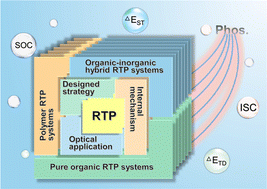Recent advances in room temperature phosphorescence materials: design strategies, internal mechanisms and intelligent optical applications
Abstract
Room temperature phosphorescence (RTP) materials comprising organic–inorganic hybrid, pure organic, and polymer RTP materials have been a research focus due to their tunable molecular structures, long emission lifetimes and extensive optical applications. Many design methods including halogen bonding interactions, heavy atom effect, metal–organic frameworks, polymerization, host–guest doping, and H-aggregation have been developed by RTP researchers. Narrowing the energy gap between the S1 and lowest Tn states, enhancing the intersystem crossing (ISC) rate, increasing the spin–orbit coupling (SOC) value and stabilizing triplet emission states are the core factors to promoting RTP performance. In this review, lots of cases of organic–inorganic hybrid, pure organic, and polymer RTP materials with advanced design strategies, excellent RTP properties and intelligent applications have been classified and sorted. Their molecule structural designability and stimulus responsiveness endow them with RTP adjustability, which makes them excellent phosphors for modern optical applications. This review provides a systematic case elaboration of typical RTP systems in recent years and identifies the future challenges to improving RTP performance and finding novel applications.

- This article is part of the themed collection: 2023 PCCP Reviews


 Please wait while we load your content...
Please wait while we load your content...